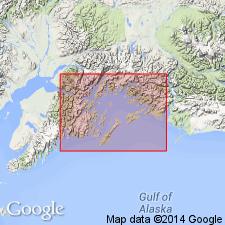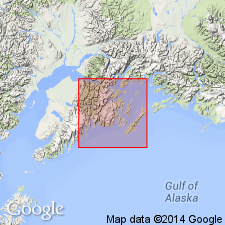
- Usage in publication:
-
- Nellie Juan granite*
- Modifications:
-
- Named
- Dominant lithology:
-
- Granite
- AAPG geologic province:
-
- Alaska Southern region
Summary:
Occurs in western part of Prince William Sound on south shore of Port Nellie Juan, southern AK. Extends along shore for about 5 mi and inland for unknown distance. Is typical biotite granite. Main body of granite is very light pink; it grades into distinctly porphyritic phase of light-gray cast. Intrudes graywacke and slates of Valdez group. [Age is Mesozoic(?)].
Source: GNU records (USGS DDS-6; Menlo GNULEX).

- Usage in publication:
-
- Nellie Juan Granite*
- Modifications:
-
- Age modified
- Geochronologic dating
- AAPG geologic province:
-
- Alaska Southern region
Summary:
K-Ar age on biotite yielded 36.1 +/-0.9 Ma (Lanphere, 1966). Sample collected on south shore of Deep Water Bay, 60 deg 19'30"N, 148 deg 23'W. Contact metamorphism has affected sedimentary rocks between Nellie Gray Granite, Eshamy Granite and granite of Culross Island, suggesting that all of these intrusive bodies may be connected at depth. Unit included in plutons of central Seward quad; map legend shows age is Oligocene.
Source: GNU records (USGS DDS-6; Menlo GNULEX).
For more information, please contact Nancy Stamm, Geologic Names Committee Secretary.
Asterisk (*) indicates published by U.S. Geological Survey authors.
"No current usage" (†) implies that a name has been abandoned or has fallen into disuse. Former usage and, if known, replacement name given in parentheses ( ).
Slash (/) indicates name conflicts with nomenclatural guidelines (CSN, 1933; ACSN, 1961, 1970; NACSN, 1983, 2005, 2021). May be explained within brackets ([ ]).

